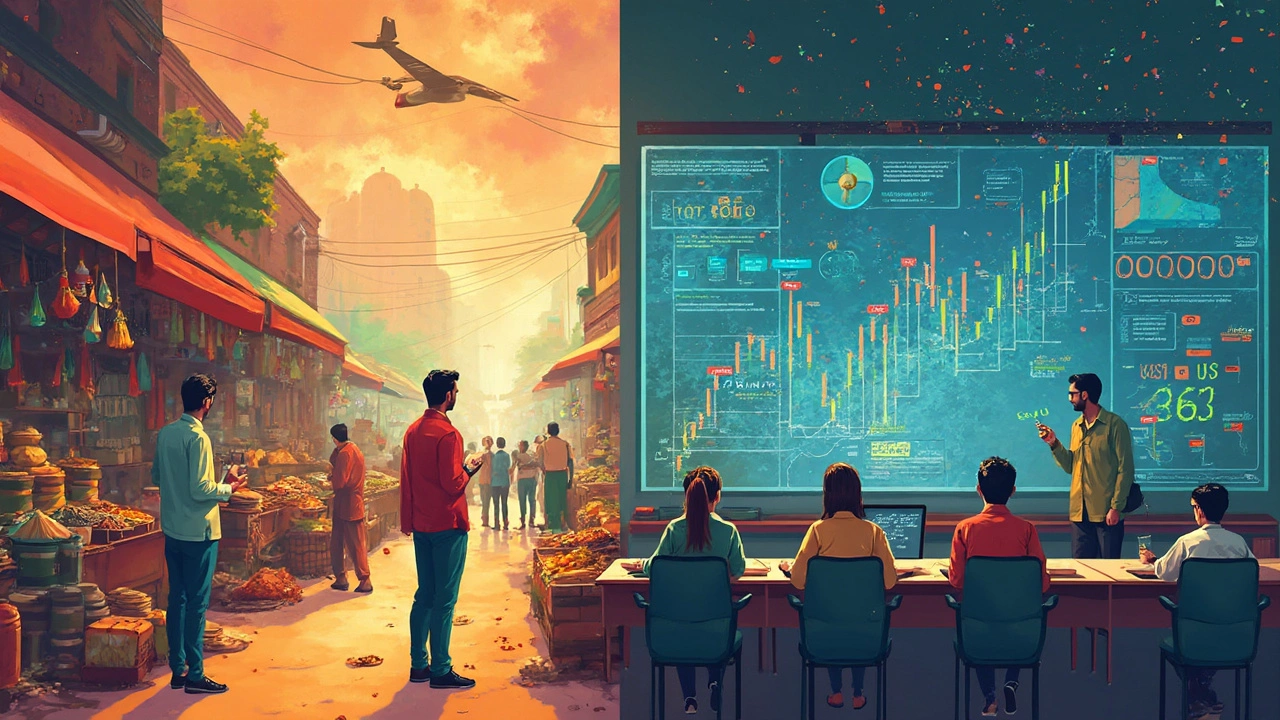Everywhere you look, somebody is talking about India’s rise as a trading powerhouse. The numbers sound big—trillions in exports and imports, deals with dozens of countries, warehouses full of everything from textiles to tech. But does that mean India really has ‘good’ trade? Or is there more under the hood?
Here’s what you should know if you’re sizing up a future in trade or eyeing those trade courses popping up everywhere. Understanding India’s trade isn’t just about tracking container ships or memorizing economic reports. It’s about knowing which industries are hot, where the money actually flows, and which skills get you hired. Without a down-to-earth look at what’s really happening, you might waste time on courses or jobs that won’t get you far.
If you want in on the action, you need to know what works—not just what’s advertised. From strange export bans to hot tips on courses that lead to real jobs, we’ll get into what makes India’s trade good, where it lags, and how you can work the system to your advantage. No filler or vague promises—just straight talk that helps you move ahead.
- What Does Good Trade Even Mean?
- India’s Trade Scorecard: Hits and Misses
- Hidden Challenges Nobody Talks About
- Skills and Courses That Trade Employers Love
- How to Get Started in India’s Trade Scene
What Does Good Trade Even Mean?
Most people mix up ‘big trade’ with ‘good trade’, but there’s a real difference. You can have huge numbers on paper and still end up with problems—unstable jobs, pointless exports, or imported stuff nobody really wants. So what counts as good trade? It boils down to three things: steady profits, jobs that matter, and trade that helps regular folks, not just big business.
Let’s break it down. First, a country’s trade should grow in a way that keeps income steady even if there are shocks internationally. Second, it should create real jobs—not just random gig work. Third, good trade actually makes daily life better by bringing in affordable products and letting local companies grow abroad. Sounds basic, right? But plenty of countries miss the mark here.
Here's what people usually look at to judge if a country has good trade:
- India trade balance (exports minus imports)
- Diversity of what’s traded, not just all eggs in one basket
- Who’s winning jobs and profits—big cities only, or smaller towns too?
- Does trade boost new industries, like green tech or IT, or just old products?
- The reputation—are products from India trusted abroad?
Some hard numbers help make it clearer. Check out this quick snapshot from the last official government stats (2023):
| Year | Total Exports (USD Billion) | Total Imports (USD Billion) | Main Export Items | Main Import Items |
|---|---|---|---|---|
| 2023 | 775 | 897 | PETROLEUM, GEMS/Jewelry, PHARMACEUTICALS, IT SERVICES | CRUDE OIL, GOLD, ELECTRONICS, MACHINERY |
Big numbers look impressive, but remember, India imports more than it exports, so there’s a trade gap. Plus, oil and gold make up a huge chunk of imports, while services (like IT) balance things out a bit on the export side.
So, good trade isn’t just about size. It’s about impact—does it add value to everyday life and the job scene? If you’re hunting for a trade job or thinking about a course, focus on skills and sectors that actually move the needle in these areas.
India’s Trade Scorecard: Hits and Misses
India’s trade scene is a mixed bag. On paper, the export numbers look impressive—especially over the past couple of years. In 2023, India crossed $770 billion in combined goods and services exports, its highest ever. Goods exports alone hit around $450 billion, with big tickets like petroleum products, chemicals, gems and jewelry, engineering goods, and pharmaceuticals leading the way.
Here’s a quick look at the top export categories:
| Item | 2023 Export Value (Billion USD) |
|---|---|
| Petroleum Products | 94 |
| Engineering Goods | 88 |
| Gems & Jewelry | 37 |
| Pharmaceuticals | 25 |
| Chemicals | 30 |
This is where things get interesting. India isn’t just exporting traditional goods anymore. There’s solid growth in software, consulting, and even processed food. IT services remain a signature export, clocking over $180 billion. International demand for Indian software pros, app creators, and fintech solutions is growing fast.
But there are misses too. Take imports—India brings in just as much, if not more, than it ships out. That’s mostly crude oil, gold, electronics, and machinery. The trade deficit—basically the gap between imports and exports—climbed to about $240 billion last year. That’s a warning sign.
One big reason? India trade still relies heavily on a few key sectors. If global oil prices shoot up, or the US and EU slow down, India’s export game gets shaky. Also, India hasn’t cracked the top 10 list of global exporters yet. China, the US, and even Germany are way ahead.
Some other points to keep in mind:
- Indian exports face tough competition from countries like Vietnam, Bangladesh, and Thailand, especially in textiles and electronics.
- Big export destinations are the US, UAE, China, and the EU. Losing ground in any of these markets stings.
- Trade agreements are slow to happen. For example, talks with the UK and the European Union have been dragging for years.
So, while India’s trade looks stronger than ever, a closer look shows that it’s still finding its feet in the global game. The next few years will be make-or-break for new sectors and smarter export strategies.

Hidden Challenges Nobody Talks About
If you look past the shiny success stories, India’s trade scene has some sneaky problems nobody likes to admit. It’s not just about exporting more or signing new deals—the practical stuff trips people up.
Let’s talk paperwork. Exporters spend weeks getting the right documents, nervously waiting for customs clearance. India ranked 68th on the World Bank’s Ease of Doing Business report in 2020, but for trading across borders, it's even tougher. The countless forms, approvals, and checks slow things down and raise costs. If your shipment gets stuck because of missing paperwork, you lose precious time and money.
Then there’s the headache of unpredictable policy changes. Sometimes the government bans the export of onions or wheat overnight to save local prices. While that helps the local market, it messes up international deals and trust. Genuine exporters suddenly need to find new buyers or eat the cost of returned goods. That’s a real risk nobody brags about in trade courses.
Logistics is another beast. India has some of the busiest ports in the world, but poor road and rail links slow things down. Trucks sit in traffic for hours; containers wait days for loading. According to a report from the Ministry of Commerce and Industry, average logistics costs in India are around 14% of GDP. Compare that to 8% in China. That eats into profit big time.
| Issue | India | China |
|---|---|---|
| Customs Clearance (Avg. Days) | 2-3 | 0.5-1 |
| Logistics Cost (% of GDP) | 14% | 8% |
| World Rank in Export Ease | 68 | 31 |
Want to talk about technology? Most small exporters still chase signatures on paper forms instead of using digital platforms. Not everyone has access to smooth online systems or the know-how to use them. That keeps things slower and more old-school than you might expect from such a huge player in India trade.
If you’re thinking of jumping into this field, it pays to choose training that teaches how to manage paperwork, handle sudden policy changes, and work with real logistics challenges. Knowing these hidden issues gives you a leg up on anyone just looking at the surface numbers.
Skills and Courses That Trade Employers Love
Landing a good job in India’s trade sector isn’t about having a generic business degree. Employers look for people who really get the rules, paperwork, and digital tools that keep trade moving. And honestly, some skills matter way more than others.
First off, if you know global trade rules (especially the basic WTO and customs stuff), you’re way ahead. Practical skills like export documentation, shipping logistics, and dealing with customs? Golden. Then there’s software—almost every decent export-import company expects you to handle tools like SAP, Tally ERP, or even basic Excel for inventory and compliance tracking.
Here’s what gets recruiters’ attention most:
- India trade regulations and documentation
- Import-export procedures (including Incoterms 2020)
- Digital trade tools—ERP software, e-invoicing, GST filing
- Freight management basics (road, rail, air, and shipping lines)
- Foreign trade policy (preferably the latest updates every year)
- Solid Excel/Analytics skills—basically being data-savvy keeps you relevant
Now, about courses. Not all trade courses are made equal—some are mostly theory, while others are closely tied to industry needs. If you’re serious, check out these tried-and-tested choices:
- Certificate in Export-Import Management—FIEO, IIFT, and IIMs offer these and recruiters love them.
- Diploma in Logistics and Supply Chain Management—NIIT, CII, and APICS certifications are strong bets.
- Government’s Niryat Bandhu Scheme—Offers trade training, with lots of real examples, especially for first-time exporters.
- GST and Trade Compliance Courses—Any certified GST training makes you a lot more employable, as GST is everywhere in logistics now.
- Short Courses on Letters of Credit & International Payment Systems—These pop up on platforms like ICAI, CII, and even Linkedin Learning.
If you want hard numbers, check this out—according to a 2024 survey by TeamLease, candidates with trade-specific certifications see a 25-30% boost in starting salaries compared to general graduates.
| Skill/Course | Average Salary Boost | Recruiter Demand |
|---|---|---|
| Export-Import Management Certificate | +28% | Very High |
| Supply Chain (Logistics) Diploma | +22% | High |
| GST Compliance Course | +18% | Moderate |
| ERP/Analytics Skill Certificate | +15% | High |
Don’t fall for old-school theory-only courses. Go for hands-on stuff where you get to work with real documents, actual logistics software, or see live case studies. If a training program offers internships, even better. That real experience helps way more than memorizing definitions or laws.

How to Get Started in India’s Trade Scene
If you’re thinking about jumping into the trade world, there’s a lot to consider—but it’s not as mysterious as it looks. A lot of folks get scared off because they hear about customs paperwork or think you need big money to start. Actually, you can get your foot in the door with the right moves, even if you’re fresh out of college or don’t come from a business family.
First up, let’s talk about the basics you’ll definitely need:
- Knowledge of how India trade (import/export) works: This isn’t just theory—you’ll need to understand shipping terms, product codes (HS codes), taxes like GST, and digital compliance for EDI filing. The top trade courses in India cover these.
- A valid Import Export Code (IEC) from Directorate General of Foreign Trade. This is step one for registering a business or freelancing in trade. You can apply online, and it’s pretty quick.
- An idea of your industry or product: Are you into textiles, spices, machinery, or electronics? Knowing which items are under export bans or get government subsidies helps a lot.
Next, getting skilled is huge. Some online trade courses get you ready fast—think Niryat Bandhu (run by DGFT), IIFT certificate programs, or even short modules from FIEO (Federation of Indian Export Organisations). For about ₹10,000–₹25,000, you’ll get hands-on training and real examples, not just textbook stuff.
No idea which sector is growing? Here’s a real snapshot of what’s big right now (2024 numbers):
| Sector | 2024 Export Value (US$ Billion) |
|---|---|
| Pharmaceuticals | 28.0 |
| Textiles & Garments | 41.5 |
| Engineering Goods | 107.0 |
| Gems & Jewellery | 32.1 |
| IT Services | 156.0 |
So if you’re betting on steady jobs, IT services and engineering exports are hot, and government support is big for pharma and textiles. There’s also a huge push for "Make in India" products to get export perks.
Ready to roll? Here’s a simple roadmap:
- Pick your target product or service and research its trade trends and government incentives.
- Sign up for a legit trade course with real placement help. Ask alumni if the course helped them get jobs or clients.
- Apply for your IEC and set up your GST if you plan to be your own boss.
- Network online—LinkedIn, FIEO events, and even WhatsApp groups for trade pros make a difference. Connections land more deals than any degree.
- Start small: Offer freelance trade compliance help, manage logistics for a local exporter, or intern at an export house before jumping in fully.
Don’t worry if the first step feels tough. Even the biggest Indian exporters started with a single order.
